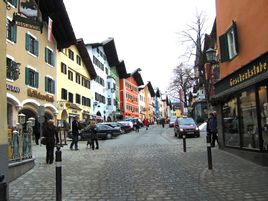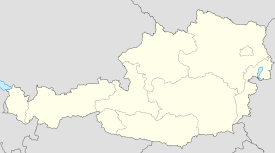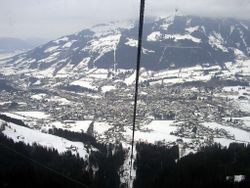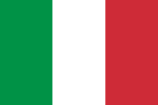Kitzbühel
| Kitzbühel | |
 |
|
 |
|
 Kitzbühel
|
|
| Country | |
|---|---|
| State | Tyrol |
| District | Kitzbühel |
| Mayor | Klaus Winkler (ÖVP) |
| Area | 58.02 km2 (22.4 sq mi) |
| Elevation | 762 m (2500 ft) |
| Population | 8,437 (1 January 2008) |
| - Density | 145 /km² (377 /sq mi) |
| Time zone | CET/CEST (UTC+1/+2) |
| Licence plate | KB |
| Postal code | 6370 |
| Area code | 05356 |
| Website | Kitzbühel municipality |
Kitzbühel is a medieval city in Tyrol, Austria, situated along the river Kitzbühler Ache, now best known as a ski resort. It is the administrative centre of the district (Bezirk) Kitzbühel.
Contents |
History
The first known settlers, who surfaced between 1100 BC and 800 BC were Illyrians mining copper in the hills near Kitzbühel.
Around 15 BC the Roman Emperor Augustus occupied the Alps and proclaimed the province Noricum. After the fall of the western Roman Empire, Bavarii settled in the Kitzbühel region around 800 and started clearing forests.
In the twelfth century the name Chizzingensspuehel is mentioned for the first time in a document of the Chiemsee monastery. Chizzo relates to a Bavarii clan, Bühel describes the location of the settlement upon a hill.
Kitzbühel became part of Upper Bavaria in 1255. Louis II, Duke of Bavaria granted Kitzbühel the rights of a city on June 6, 1271, and it was fortified with mighty city walls. During the next centuries the city became a focus of trade, grew steadily and never was affected by wars. So the city walls were razed at the level of the first floor and used for building new houses.
When Margarete Maultasch married Bavarii Duke Louis V the Brandenburger in 1342, Kitzbühel became part of Tyrol. After the Peace of Schärding (1369) it was given back to Bavaria. On June 30, 1504 Kitzbühel became part of Tyrol again when Austrian Emperor Maximilian conquered Kitzbühel and Kufstein.
Maximilian took mortgage on Kitzbühel, and so at the end of sixteenth century it came under the rule of the Counts of Lamberg. On May 1, 1840 Kitzbühel was given to the state of Austria in a ceremony.
The wars of the eighteenth and nineteenth century didn't reach the city, whereas some inhabitants participated in the Tyrolean rebellion against Napoleon. Kitzbühel once more became part of Bavaria after the Treaty of Pressburg, but was reunited with Tyrol after the fall of Napoleon, at the Congress of Vienna.
When Emperor Franz Joseph finally resolved the remaining constitutional uncertainties, and furthermore railway construction of the Salzburg-Tiroler-Bahn was finished in 1875, the city's trade and industry flourished. Also during World War I and World War II Kitzbühel remained far from the areas of war.

Tourism and sport
Kitzbühel is one of Austria's best known and fanciest winter sport resorts, situated between the mountains Hahnenkamm (5616 ft., 1712 m) and Kitzbühler Horn (6548 ft., 1996 m). The Hahnenkamm is home of the annual world cup ski races, including the circuit's most important event, the downhill race on the famous Streif slope. This downhill is counted as one of the hardest downhill competitions in the world cup. During summer time Kitzbühel also hosts an ATP tennis tournament on clay, the Austrian Open.
In 2007 and 2008 ITU Triathlon World Cup races took place at the local Schwarzsee lake.[1]
The Kitzbüheler Alpenrallye is an annual festival of historic automobiles. It was first held in 1988. The first trip of the United Buddy Bears was 2004 to Kitzbühel, following by the first trip into the "big wide world" - when they went to Hong Kong and many other metropolises on all five continents.
A further sight is the 3S Aerial Tramway, the aerial tramway with the highest span in the world.
Transport
Highway B161, which connects St. Johann in Tirol with Mittersill, passes through Kitzbühel, intersecting here with highway B170 to Wörgl. Kitzbühel Bahnhof, Kitzbühel Hahnenkamm, and Kitzbühel Schwarzsee are train stops at the Salzburg-Tiroler-Bahn. Kitzbuhel Bahnhof is also a major bus stop for busses running to Lienz and Worgl. Most major trains stop at Worgl, and the express train (or REX) stops at both the Bahnhof and Hahnenkamm.
| Kitzbühel | ||||||||||||||||||||||||||||||||||||||||||||||||||||||||||||
|---|---|---|---|---|---|---|---|---|---|---|---|---|---|---|---|---|---|---|---|---|---|---|---|---|---|---|---|---|---|---|---|---|---|---|---|---|---|---|---|---|---|---|---|---|---|---|---|---|---|---|---|---|---|---|---|---|---|---|---|---|
| Climate chart () | ||||||||||||||||||||||||||||||||||||||||||||||||||||||||||||
|
||||||||||||||||||||||||||||||||||||||||||||||||||||||||||||
|
||||||||||||||||||||||||||||||||||||||||||||||||||||||||||||
| Historical populations | ||
|---|---|---|
| Year | Pop. | %± |
| 1869 | 2,982 | — |
| 1880 | 3,167 | 6.2% |
| 1890 | 3,290 | 3.9% |
| 1900 | 3,453 | 5.0% |
| 1910 | 4,021 | 16.4% |
| 1923 | 4,378 | 8.9% |
| 1934 | 5,294 | 20.9% |
| 1939 | 5,419 | 2.4% |
| 1951 | 7,211 | 33.1% |
| 1961 | 7,744 | 7.4% |
| 1971 | 8,020 | 3.6% |
| 1981 | 7,840 | −2.2% |
| 1991 | 8,119 | 3.6% |
| 2001 | 8,574 | 5.6% |
| 2008 | 8,437 | −1.6% |
| Source: Statistik Austria | ||
People
- Karl Wilhelm von Dalla Torre (1850-1928), entomologist and botanist
- Alfons Walde (1891-1958), expressionist painter and architect
- Peter Aufschnaiter (1899-1973), mountaineer and geographer
- Leni Riefenstahl (1902-2003), nazi filmmaker
- Anderl Molterer (born 1931), alpine skier
- Ernst Hinterseer (born 1932), alpine skier
- Hias Leitner (born 1935), alpine skier
- Toni Sailer (1935-2009), alpine skier
- Georg Hochfilzer (born 1937), Famous International Hotel Director of the Hotel Bristol in Vienna
- Christl Haas (1943-2001), alpine skier
- Roman Strobl (born 1951), Austrian sculptor
- Hansi Hinterseer (1954), alpine skier and singer
- Haddaway (born 1965), Famous musician, most famous song is "What is love"
- Klaus Sulzenbacher (born 1965), Nordic skier
- Markus Gandler (born 1966), cross-country skier
- Jörg Jaksche (born 1976), professional bicycle racer
International relations
Twin towns — Sister cities
 Greenwich, United States, since 1961
Greenwich, United States, since 1961 Yamagata, Japan, since 1963
Yamagata, Japan, since 1963 Sun Valley, United States, since 1967
Sun Valley, United States, since 1967 Sterzing, Italy, since 1971
Sterzing, Italy, since 1971 Rueil-Malmaison, France, since 1979
Rueil-Malmaison, France, since 1979 Bad Soden am Taunus, Germany, since 1984
Bad Soden am Taunus, Germany, since 1984
Notes and references
- ↑ "2008 Kitzbuhel BG Triathlon World Cup". International Triathlon Union. http://www.triathlon.org/?call=TVRFdw==&id=MTEyMg==&kee. Retrieved 2008-08-04.
- ↑ "Partnerstädte" (in German). Stadtgemeinde Kitzbühel. http://www.kitzbuehel.eu/system/web/zusatzseite.aspx?detailonr=34869817. Retrieved 2008-08-04.
See also
External links
|
|||||